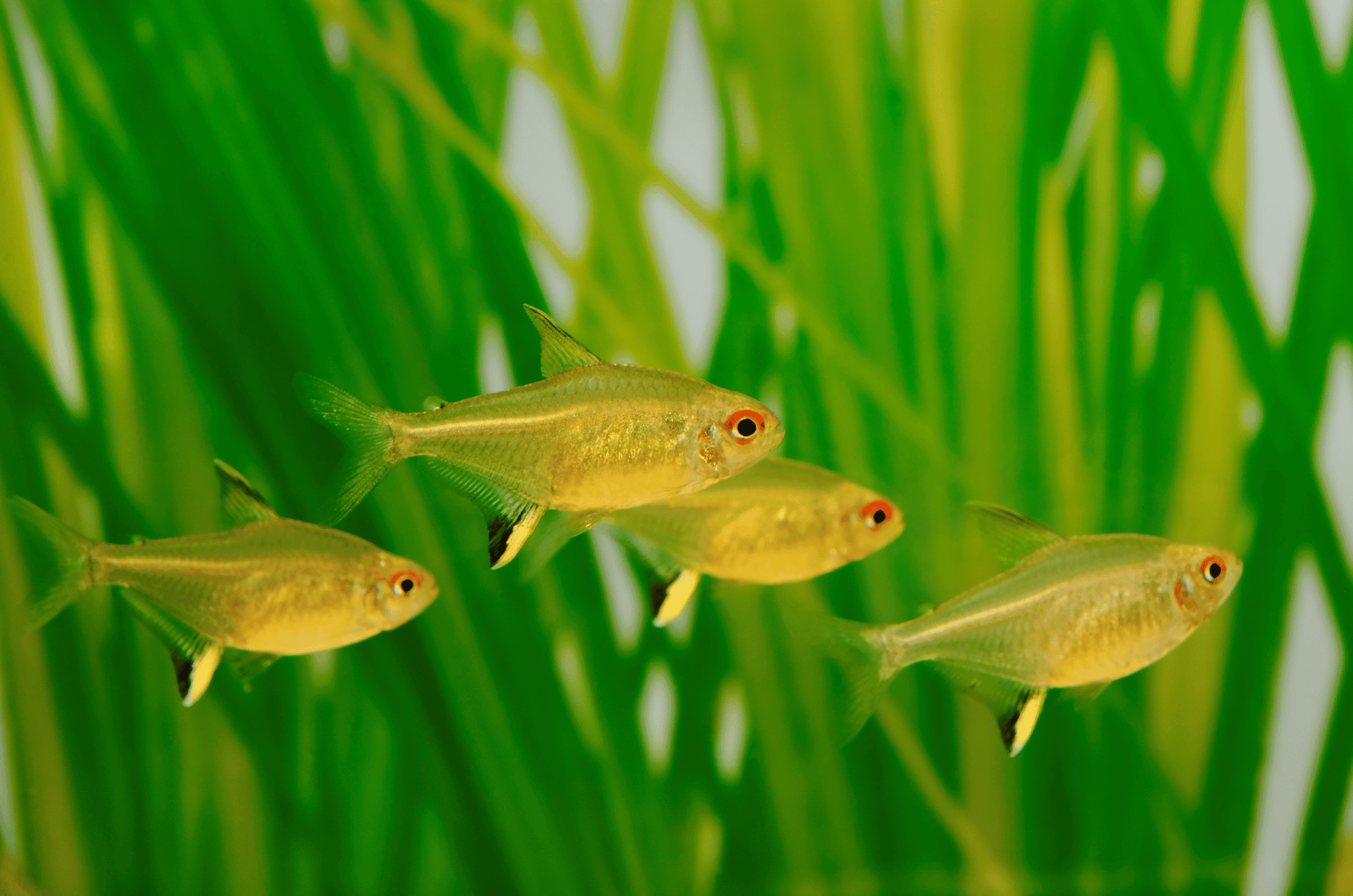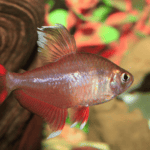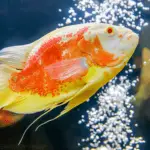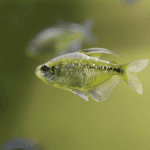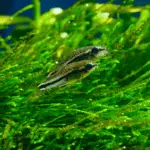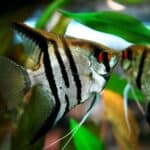Lemon Tetras, scientifically known as Hyphessobrycon pulchripinnis, are a popular species of freshwater fish among aquarium enthusiasts due to their bright colors and active behavior. Originating from the waters of South America, particularly in the Amazon basin, these small, vibrant fish can bring a touch of nature’s beauty to any home aquarium.
As a schooling fish, Lemon Tetras tend to display the most impressive characteristics when kept in groups. They exhibit vibrant coloration and strong schooling behavior, creating an engaging addition to a community tank. In this article, we will explore the essential aspects of these unique freshwater fish, including their appearance, habitat, and care requirements.
Caring for Lemon Tetras is relatively straightforward, making them a suitable option for both novice and experienced aquarists. We will delve into their ideal tank conditions, dietary needs, and compatible tank mates to help you provide the best possible environment for your Lemon Tetra fish. So grab your aquarium net and let’s dive into the captivating world of Hyphessobrycon pulchripinnis.
Habitat and Origin
Natural Environment
In its natural environment, the Lemon Tetra (Hyphessobrycon pulchripinnis) thrives in calm freshwater environments. These include small streams, rivers, and ponds that are densely vegetated with plenty of hiding spots. The water in their habitat usually has a slightly acidic pH, with soft, dark, and tannin-stained water due to decaying organic matter.
Location
Lemon Tetras originate from South America, specifically in the Amazon River basin. They are commonly found in Brazil’s clearwater and blackwater systems, particularly in the Rio Tapajós and its surrounding tributaries.
To replicate their natural habitat in our home aquariums, we should aim to include aquatic plants, driftwood, and areas for hiding. Maintaining a stable water temperature, soft water, and slightly acidic pH can also help ensure their health and longevity.
Physical Characteristics
Color and Appearance
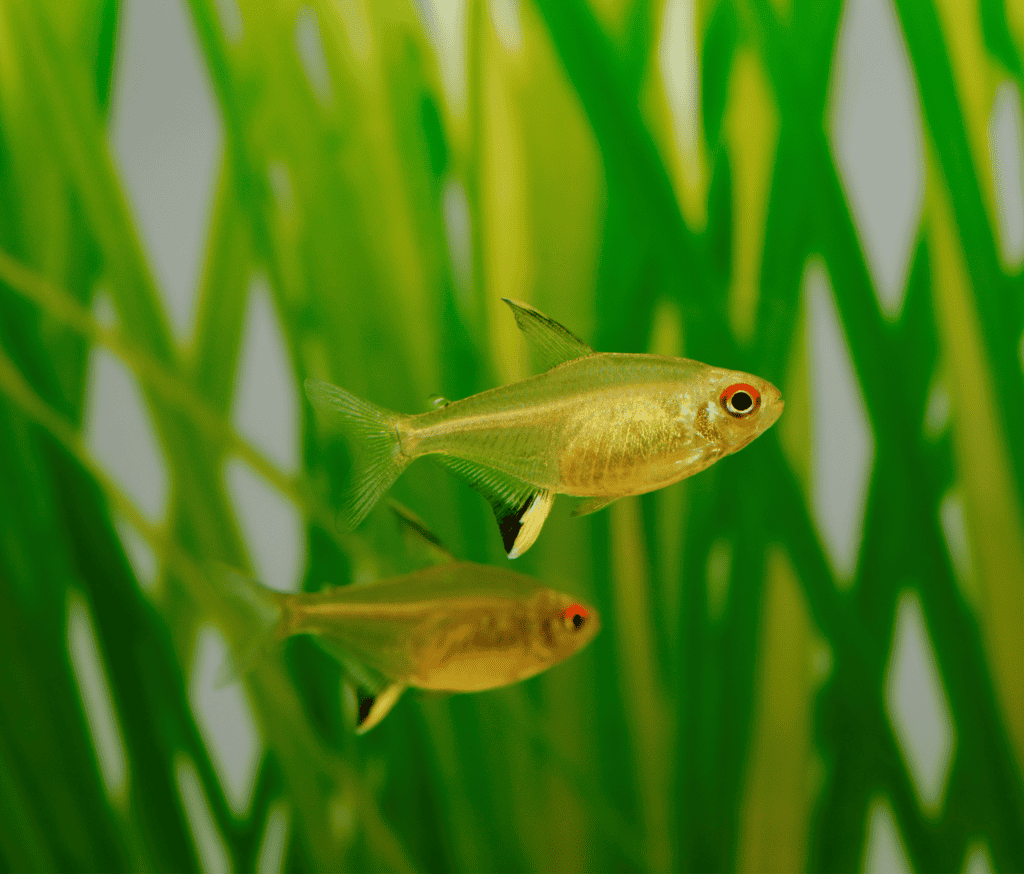
In our observation, Lemon Tetras display a brilliant yellow coloration, which is accentuated by a transparent appearance. The most striking feature is their eyes, which exhibit a stunning red color. As the name suggests, their vibrant yellow color gives them the appearance of lemons. This bright color can be observed prominently at the posterior side of the fish, just behind the gill cover. The intensity of the yellow hue directly correlates with the health of the fish, and it tends to fade when they are sick or under stress.
The dorsal fin of a Lemon Tetra is iridescent and typically tinted with yellow, whereas the anal and adipose fins are tinged with a blackish-gray color. In comparison, the other fins, such as the pectoral fins, are largely transparent.
Size and Anatomy
Lemon Tetras (Hyphessobrycon pulchripinnis) are small in size, measuring between 1.5 – 2 inches (3.8 – 5.1 cm) in length. Despite their small size, they exhibit quite a distinctive anatomy.
| Feature | Description |
|---|---|
| Dorsal Fin | Iridescent, yellow-tinted |
| Anal Fin | Blackish-gray tinted |
| Adipose Fin | Blackish-gray tinted |
| Pectoral Fins | Transparent |
In addition to their brightly colored scales, Lemon Tetras also display a few key anatomical structures that differentiate them from other tetra species. For example, their anal fin is elongated, which gives them excellent maneuverability in the water.
Behavior and Temperament
Swimming and Schooling Behavior
Lemon Tetras are known for their peaceful and calm temperament, making them an ideal choice for beginner aquarists or those looking to add a pop of color to a community tank. These vibrant little fish are active swimmers that thrive in groups, primarily in the middle and upper parts of the water column. As schooling fish, they feel most comfortable in numbers, typically a group of six or more. When kept in large schools, they exhibit stunning, synchronized swimming patterns.
It is important to provide our Lemon Tetras with ample space in the aquarium to allow them to indulge in their natural schooling behavior. We should also consider incorporating plenty of hiding spots, such as plants and rocks, to help them feel secure in their environment.
Interaction with Other Species
When it comes to interacting with other species, Lemon Tetras exhibit a peaceful nature, making them excellent additions to most community tanks. They tend to coexist harmoniously with other non-aggressive, similarly-sized fish. Some suitable tank mates include Corydoras catfish, small Rasboras, and other Tetra species.
While Lemon Tetras are not known for aggression, we should avoid combining them with larger, more aggressive or predatory fish, as they may become a target. Additionally, it is crucial to monitor the tank for any signs of stress or aggression and take appropriate action to maintain a harmonious community.
Together, the combination of calm demeanor, active swimming, and schooling behavior makes Lemon Tetras a delightful and visually captivating addition to our community tanks.
Tank Requirements and Setup
Tank Size and Water Conditions
For Lemon Tetras, we recommend a minimum tank size of 20 gallons to accommodate a small school of these fish. Their ideal water temperature range is between 72°F and 82°F (22°C to 28°C), and they thrive best in water with a slight acidity. It’s best to maintain pH levels between 6.0 and 7.5, with a water hardness in the range of 4-15 dGH.
In terms of water parameters, a well-maintained filtration system is essential to ensure the stability of the water quality. Additionally, performing regular water tests using a water test kit will help monitor the water conditions and maintain the appropriate levels. Encouraging a moderate water flow aids in replicating the natural habitat of Lemon Tetras.
Decor and Equipment
When setting up a Lemon Tetra tank, we recommend using a soft substrate such as sand or fine gravel, as these fish tend to search for food near the bottom. The addition of live plants like Anubias, Java Fern, and moss not only provides shelter but also contributes to a natural look and enhances water quality. For the upper part of the tank, floating plants are ideal to create shade and cover, making the fish feel more secure.
To provide additional hiding spots and further mimic their natural environment, consider incorporating rocks, driftwood, and caves in the tank decor. As Lemon Tetras are best suited for community tanks, creating a visually engaging environment with various plants and decor will encourage them to interact and display their bright colors.
When it comes to lighting, Lemon Tetras are not very demanding, and moderate lighting is sufficient. Ensure that the tank is equipped with a heater and an efficient filtration system to maintain optimal water conditions for these fish. A well-planned tank setup will not only keep your Lemon Tetras healthy, but also create an attractive and enjoyable environment for them and their tank mates.
Feeding and Diet
Lemon Tetras are omnivorous fish that require a balanced diet to stay healthy and active. We can achieve this by providing them with a mixture of high-quality flake and pellet foods, along with occasional servings of live, freeze-dried, or frozen foods.
For their daily meals, we can start by offering them small-sized fish food flakes such as tropical flake mixes. These flakes usually contain a good balance of proteins, fats, and carbohydrates. Pellet foods are another reliable option for Lemon Tetras, especially if they are designed specifically for small, tropical fish and contain essential nutrients they need.
To ensure variety in their diet and promote optimal health, we should also include live or frozen foods in their feeding regimen. Brine shrimp, daphnia, and bloodworms are excellent choices for Lemon Tetras as they are palatable and nutritious. Adding these foods a couple of times a week can help support their immune system and keep their colors vibrant.
Feeding Lemon Tetras should be done with care, and we should avoid overfeeding them. Providing just enough food that they can consume within 2-3 minutes, twice a day, should be sufficient. Monitoring their eating habits and adjusting food quantities as needed ensures a clean tank environment and optimal health for our fish.
In summary, a varied and balanced diet consisting of flake and pellet foods, supplemented with live or frozen foods, will help keep our Lemon Tetras healthy, active, and showing off their dazzling colors. Don’t forget to watch their feeding habits and adjust portion sizes as needed!
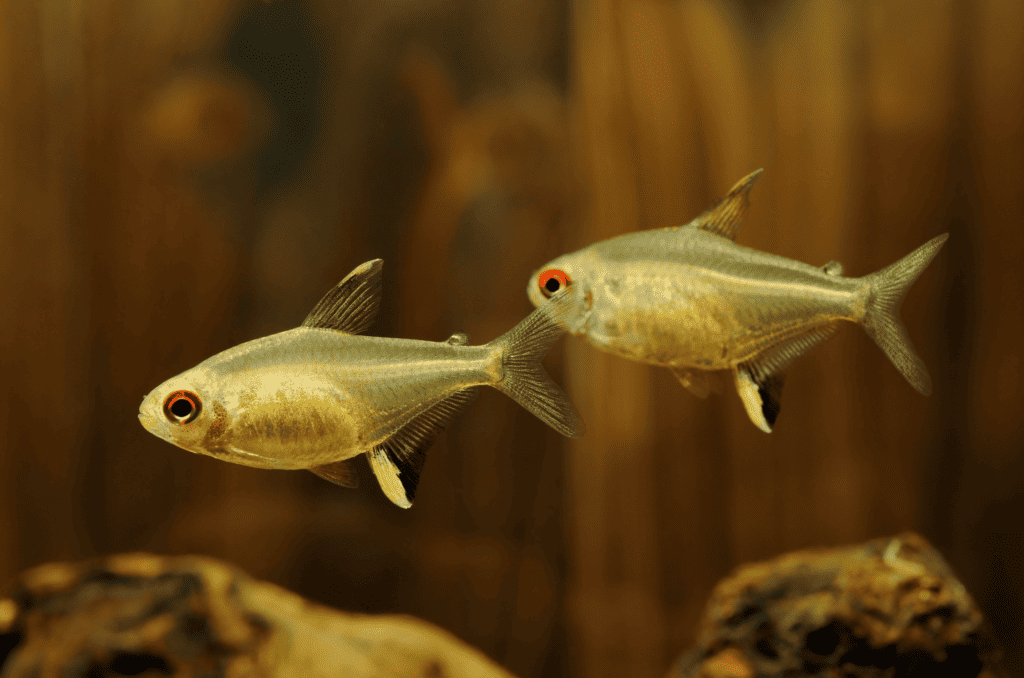
Health and Common Diseases
Lemon Tetras, like any other fish, can sometimes encounter health issues and diseases. In this section, we will discuss the most common health concerns these fish might face and how to deal with them.
Parasitic Infections
One common problem that Lemon Tetras can experience is Ich or White Spot Disease, which is a parasitic skin infection. Signs of Ich include small white spots on the fish’s body and fins, excessive fish scratching against objects, and labored breathing. To treat Ich, we recommend increasing the water temperature to 86°F and adding aquarium salt or an Ich-specific medication.
Another parasitic infection commonly faced by Lemon Tetras is flukes, which are microscopic flatworms that can cause skin, gill, and internal organ damage. Symptoms include rapid breathing, lethargy, and a decline in their health. Treatment options for flukes include medicated baths, anti-parasitic medications, and maintaining optimal water quality.
Common Ailments and Treatments
Apart from parasitic infections, Lemon Tetras can also encounter other common diseases:
- Bacterial Infections: These can manifest as fin rot, mouth rot, and abdominal swelling.
- Fungal Infections: These are typically characterized by cotton-like growths on the fish’s body.
Both bacterial and fungal infections can be treated by improving water quality and using appropriate medications.
-
Water Changes: Performing regular water changes is essential in preventing common diseases. We recommend changing 20-30% of the water weekly. This helps maintain optimal water quality and reduce stress.
-
Preventing Infections: To minimize the risk of infections in your Lemon Tetras, quarantine new fish and plants before introducing them to your tank and maintain your tank’s cleanliness.
In conclusion, by keeping an eye on your Lemon Tetras’ health, maintaining good water quality, and providing a proper diet, you can ensure that your fish lead healthy and happy lives.
Breeding Lemon Tetras
Breeding Lemon Tetras can be a rewarding experience for aquarium enthusiasts. We’ll cover the essential aspects of breeding these colorful fish, along with information on their lifespan, captive care, and cost.
To begin the breeding process, it’s crucial to set up a separate breeding tank. A 10 to 20-gallon tank with soft, slightly acidic water, and a temperature of 78-82°F is ideal. Providing dense vegetation, like java moss, will give the fish a suitable spawning site and hide the eggs from the adults.
Lemon Tetras reach sexual maturity at around 6 to 12 months old. Once they’re ready to breed, it’s essential to condition the fish with high-quality food like live or frozen brine shrimp, daphnia, or bloodworms. This allows the parents to produce healthy and viable eggs.
When the females are noticeably plumper, move a compatible breeding pair to the breeding tank. The female will lay between 50-150 eggs on the plant leaves or other substrate. After spawning, remove the parents from the tank to prevent them from eating the eggs.
Eggs will hatch within 24-36 hours, and the fry will become free-swimming after 3-5 days. Please feed them specialty fry food or finely crushed flake food to ensure their growth and survival. Once they’re large enough, the young fish can be introduced to the community tank.
The lifespan of Lemon Tetras in captivity is typically around 5-8 years, depending on factors like tank conditions and diet. Providing them with a well-maintained tank, balanced nutrition, and stress-free environment will contribute to their long and healthy lives.
In terms of cost, Lemon Tetras are quite affordable. The price for a single fish usually ranges from $2-$4, depending on factors like age, size, and availability. Keep in mind that these are schooling fish, and it’s best to maintain a group of at least six for their well-being and vibrant behavior.
Breeding Lemon Tetras is an achievable and enjoyable process. By ensuring proper tank conditions, diet, and care, owners can nurture their fish into a thriving community that enhances the aesthetics and biodiversity of the aquarium.
Compatibility and Tank Mates
Compatible Fish Species
Lemon Tetras are known for being peaceful community fish, which makes them suitable tank mates for a variety of other tropical fish species. They thrive in shoals, so it’s best to keep a group of at least six Lemon Tetras together in a community aquarium. This will allow them to establish their own social hierarchy and reduce stress among the group.
Other compatible fish species include Guppies, which are also peaceful and can coexist harmoniously with Lemon Tetras. Cichlids, on the other hand, may not be the best choice as tank mates for Lemon Tetras, as some Cichlid species can be aggressive and territorial.
One thing to keep in mind when selecting tank mates for your Lemon Tetras is to avoid any fish that are excessively larger or more aggressive, as this can lead to stress, injury, or even death for the Tetras.
Invertebrates and Crustacea
In addition to being compatible with various fish species, Lemon Tetras can also live alongside certain invertebrates and crustaceans in community aquariums. For example, they can coexist with small shrimp species like Cherry Shrimp and Amano Shrimp, as well as snails such as Nerite and Mystery Snails.
However, it’s essential to monitor the tank conditions closely to ensure all inhabitants’ health and well-being. For example, regular water changes and maintaining an appropriate temperature range for both the fish and invertebrates living in the community aquarium is crucial.
In summary, Lemon Tetras make great additions to community aquariums, given their peaceful nature and compatibility with various fish species, invertebrates, and crustaceans. As long as the tank conditions are well-maintained, these beautiful tropical fish can thrive alongside their tank mates, providing a visually stunning display for aquarists to enjoy.
Frequently Asked Questions
What is the ideal water temperature for Lemon Tetras?
Lemon Tetras thrive in water temperatures between 72°F and 82°F (22°C to 28°C). Consistent water temperature is crucial for their well-being. However, fluctuating temperatures can stress the fish and lead to diseases. You should aim to maintain consistent water temperature within the recommended range using a good quality aquarium heater.
How long is the lifespan of Lemon Tetras?
Lemon Tetras have a lifespan of approximately 5 to 8 years with proper care. Following the recommended water parameters and providing them a balanced diet, as well as regular tank cleaning, can increase their chances of leading a long and healthy life.
What are the suitable water parameters for Lemon Tetras?
Maintaining proper water parameters is essential for Lemon Tetras’ well-being. These fish prefer a pH range of 6.0 to 8.0 and a water hardness level between 3 and 15 degrees dGH. Regular water testing and changes are important for ensuring these parameters remain consistent and stable.
Do Lemon Tetras exhibit aggression towards other fish?
Lemon Tetras are generally peaceful and get along with other non-aggressive fish species. They make great additions to community tanks. However, it is important to ensure that the tank has enough hiding spaces and plants for the fish to establish their territories and reduce any potential stress or aggression.
What are the key aspects of breeding Lemon Tetras?
Breeding Lemon Tetras requires a separate breeding tank, slightly acidic water, and optimal water parameters. Good quality diets will also improve their breeding potential. Once spawning occurs and the eggs are laid, it is best to remove the adult fish, as they can potentially eat the eggs. The fry will hatch within 24 to 36 hours and can be fed infusoria or other suitable fry food.
How big do Lemon Tetras grow?
Lemon Tetras can grow up to a size of 1.5 inches (about 4 centimeters). Providing them with ample swimming space, along with proper water conditions and diet, contribute to their growth and overall health. A well-maintained tank and healthy environment play a significant role in their size and longevity.
